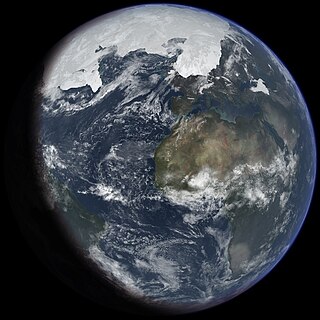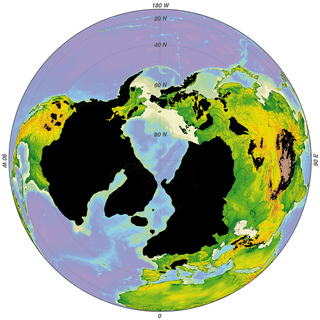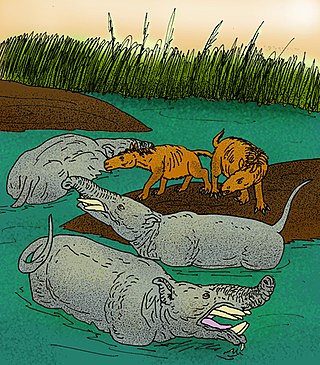The Middle Pliocene Warm Period (mPWP), also known as the Mid-Piacenzian Warm Period or the Pliocene Thermal Maximum, was an interval of warm climate during the Pliocene epoch that lasted from 3.3 to 3.0 million years ago (Ma). [1]
The Middle Pliocene Warm Period (mPWP), also known as the Mid-Piacenzian Warm Period or the Pliocene Thermal Maximum, was an interval of warm climate during the Pliocene epoch that lasted from 3.3 to 3.0 million years ago (Ma). [1]
The global average temperature in the mid-Pliocene was 2–3 °C higher than today, [2] global sea level 25 meters higher, [3] and the Northern Hemisphere ice sheet was ephemeral before the onset of extensive glaciation over Greenland that occurred in the late Pliocene around 3 Ma. [4] Global precipitation was marginally increased by 0.09 mm/yr according to CCSM4 simulations. [5] As during the Quaternary glaciation, glacial-interglacial cycles existed during the mPWP and it was not a uniform and stable climatic interval. [6]
Carbon dioxide concentration during the Middle Pliocene has been estimated at around 400 ppmv from 13C/12C ratio in organic marine matter [7] and stomatal density of fossilised leaves, [8] although lower estimates of between 330 and 394 ppm over the course of the whole mPWP and 391 ppm in the KM5c interglacial, during the warmest phase of the mPWP, have been given. [9]


The mPWP is considered a potential analogue of future climate. [10] [11] The intensity of the sunlight reaching the Earth, the global geography, and carbon dioxide concentrations were similar to present. Furthermore, many mid-Pliocene species are extant, helping calibrate paleotemperature proxies. Model simulations of mid-Pliocene climate produce warmer conditions at middle and high latitudes, as much as 10–20 °C warmer than today above 70°N. They also indicate little temperature variation in the tropics. Model-based biomes are generally consistent with Pliocene palaeobotanical data indicating a northward shift of the tundra and taiga and an expansion of savanna and warm-temperate forest in Africa and Australia. [12] The increased intensity of tropical cyclones during the mPWP has been cited as evidence that intensification of such storms will occur as anthropogenic global warming continues. [13]

An ice age is a long period of reduction in the temperature of Earth's surface and atmosphere, resulting in the presence or expansion of continental and polar ice sheets and alpine glaciers. Earth's climate alternates between ice ages, and greenhouse periods during which there are no glaciers on the planet. Earth is currently in the ice age called Quaternary glaciation. Individual pulses of cold climate within an ice age are termed glacial periods, and intermittent warm periods within an ice age are called interglacials or interstadials.
The Miocene is the first geological epoch of the Neogene Period and extends from about 23.03 to 5.333 million years ago (Ma). The Miocene was named by Scottish geologist Charles Lyell; the name comes from the Greek words μείων and καινός and means "less recent" because it has 18% fewer modern marine invertebrates than the Pliocene has. The Miocene is preceded by the Oligocene and is followed by the Pliocene.

The Neogene is a geologic period and system that spans 20.45 million years from the end of the Paleogene Period 23.03 million years ago (Mya) to the beginning of the present Quaternary Period 2.58 million years ago. The Neogene is sub-divided into two epochs, the earlier Miocene and the later Pliocene. Some geologists assert that the Neogene cannot be clearly delineated from the modern geological period, the Quaternary. The term "Neogene" was coined in 1853 by the Austrian palaeontologist Moritz Hörnes (1815–1868). The earlier term Tertiary Period was used to define the span of time now covered by Paleogene and Neogene and, despite no longer being recognized as a formal stratigraphic term, "Tertiary" still sometimes remains in informal use.
The Pliocene is the epoch in the geologic time scale that extends from 5.333 million to 2.58 million years ago. It is the second and most recent epoch of the Neogene Period in the Cenozoic Era. The Pliocene follows the Miocene Epoch and is followed by the Pleistocene Epoch. Prior to the 2009 revision of the geologic time scale, which placed the four most recent major glaciations entirely within the Pleistocene, the Pliocene also included the Gelasian Stage, which lasted from 2.588 to 1.806 million years ago, and is now included in the Pleistocene.

The Pleistocene is the geological epoch that lasted from c. 2.58 million to 11,700 years ago, spanning the Earth's most recent period of repeated glaciations. Before a change was finally confirmed in 2009 by the International Union of Geological Sciences, the cutoff of the Pleistocene and the preceding Pliocene was regarded as being 1.806 million years Before Present (BP). Publications from earlier years may use either definition of the period. The end of the Pleistocene corresponds with the end of the last glacial period and also with the end of the Paleolithic age used in archaeology. The name is a combination of Ancient Greek πλεῖστος (pleîstos), meaning "most", and καινός, meaning "new".

The Paleogene Period is a geologic period and system that spans 43 million years from the end of the Cretaceous Period 66 million years ago (Mya) to the beginning of the Neogene Period 23.03 Mya. It is the first part of the Cenozoic Era of the present Phanerozoic Eon. The earlier term Tertiary Period was used to define the time now covered by the Paleogene Period and subsequent Neogene Period; despite no longer being recognized as a formal stratigraphic term, "Tertiary" still sometimes remains in informal use. Paleogene is often abbreviated "Pg", although the United States Geological Survey uses the abbreviation "Pe" for the Paleogene on the Survey's geologic maps.

Climate variability includes all the variations in the climate that last longer than individual weather events, whereas the term climate change only refers to those variations that persist for a longer period of time, typically decades or more. Climate change may refer to any time in Earth's history, but the term is now commonly used to describe contemporary climate change, often popularly referred to as global warming. Since the Industrial Revolution, the climate has increasingly been affected by human activities.

The Last Interglacial, also known as the Eemian among other names was the interglacial period which began about 130,000 years ago at the end of the Penultimate Glacial Period and ended about 115,000 years ago at the beginning of the Last Glacial Period. It corresponds to Marine Isotope Stage 5e. It was the second-to-latest interglacial period of the current Ice Age, the most recent being the Holocene which extends to the present day. During the Last Interglacial, the proportion of CO2 in the atmosphere was about 280 parts per million. The Last Interglacial was one of the warmest periods of the last 800,000 years, with temperatures comparable to and at times warmer than the contemporary Holocene interglacial, with the maximum sea level being up to 6 to 9 metres higher than at present, with global ice volume likely also being smaller than the Holocene interglacial.

There have been five or six major ice ages in the history of Earth over the past 3 billion years. The Late Cenozoic Ice Age began 34 million years ago, its latest phase being the Quaternary glaciation, in progress since 2.58 million years ago.
A glacial period is an interval of time within an ice age that is marked by colder temperatures and glacier advances. Interglacials, on the other hand, are periods of warmer climate between glacial periods. The Last Glacial Period ended about 15,000 years ago. The Holocene is the current interglacial. A time with no glaciers on Earth is considered a greenhouse climate state.
The geologic temperature record are changes in Earth's environment as determined from geologic evidence on multi-million to billion (109) year time scales. The study of past temperatures provides an important paleoenvironmental insight because it is a component of the climate and oceanography of the time.
The Holocene Climate Optimum (HCO) was a warm period in the first half of the Holocene epoch, that occurred in the interval roughly 9,500 to 5,500 years BP, with a thermal maximum around 8000 years BP. It has also been known by many other names, such as Altithermal, Climatic Optimum, Holocene Megathermal, Holocene Optimum, Holocene Thermal Maximum, Hypsithermal, and Mid-Holocene Warm Period.
The Piacenzian is in the international geologic time scale the upper stage or latest age of the Pliocene. It spans the time between 3.6 ± 0.005 Ma and 2.588 ± 0.005 Ma. The Piacenzian is after the Zanclean and is followed by the Gelasian.

The Quaternary glaciation, also known as the Pleistocene glaciation, is an alternating series of glacial and interglacial periods during the Quaternary period that began 2.58 Ma and is ongoing. Although geologists describe this entire period up to the present as an "ice age", in popular culture this term usually refers to the most recent glacial period, or to the Pleistocene epoch in general. Since Earth still has polar ice sheets, geologists consider the Quaternary glaciation to be ongoing, though currently in an interglacial period.

The late Paleozoic icehouse, also known as the Late Paleozoic Ice Age (LPIA) and formerly known as the Karoo ice age, was an ice age that began in the Late Devonian and ended in the Late Permian, occurring from 360 to 255 million years ago (Mya), and large land-based ice-sheets were then present on Earth's surface. It was the second major icehouse period of the Phanerozoic.

Marine Isotope Stage 11 or MIS 11 is a Marine Isotope Stage in the geologic temperature record, covering the interglacial period between 424,000 and 374,000 years ago. It corresponds to the Hoxnian Stage in Britain.
The Middle Miocene Climatic Transition (MMCT) was a relatively steady period of climatic cooling that occurred around the middle of the Miocene, roughly 14 million years ago (Ma), during the Langhian stage, and resulted in the growth of ice sheet volumes globally, and the reestablishment of the ice of the East Antarctic Ice Sheet (EAIS). The term Middle Miocene disruption, alternatively the Middle Miocene extinction or Middle Miocene extinction peak, refers to a wave of extinctions of terrestrial and aquatic life forms that occurred during this climatic interval. This period was preceded by the Middle Miocene Climatic Optimum (MMCO), a period of relative warmth from 18 to 14 Ma. Cooling that led to the Middle Miocene disruption is primarily attributed CO2 being pulled out of the Earth's atmosphere by organic material before becoming caught in different locations like the Monterey Formation. These may have been amplified by changes in oceanic and atmospheric circulation due to continental drift. Additionally, orbitally paced factors may also have played a role.

The Late Cenozoic Ice Age, or Antarctic Glaciation, began 34 million years ago at the Eocene-Oligocene Boundary and is ongoing. It is Earth's current ice age or icehouse period. Its beginning is marked by the formation of the Antarctic ice sheets.
Bette Otto-Bliesner is an earth scientist known for her modeling of Earth's past climate and its changes over different geological eras.
Global paleoclimate indicators are the proxies sensitive to global paleoclimatic environment changes. They are mostly derived from marine sediments. Paleoclimate indicators derived from terrestrial sediments, on the other hand, are commonly influenced by local tectonic movements and paleogeographic variations. Factors governing the Earth's climate system include plate tectonics, which controls the configuration of continents, the interplay between the atmosphere and the ocean, and the Earth's orbital characteristics. Global paleoclimate indicators are established based on the information extracted from the analyses of geologic materials, including biological, geochemical and mineralogical data preserved in marine sediments. Indicators are generally grouped into three categories; paleontological, geochemical and lithological.